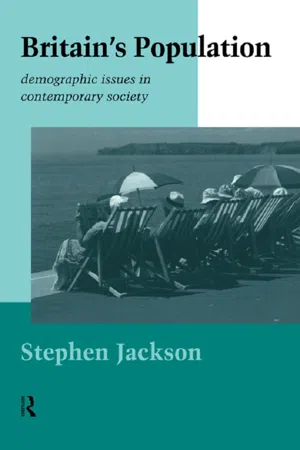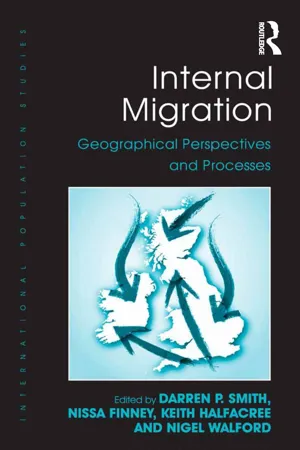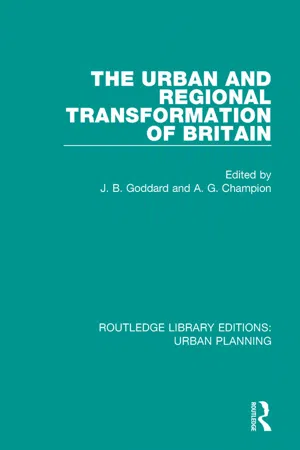Geography
UK Migration
UK migration refers to the movement of people into and out of the United Kingdom. It encompasses both international migration, involving individuals from other countries, and internal migration, which involves movement within the UK. Factors influencing UK migration include economic opportunities, political stability, and social factors, and it has significant impacts on population distribution, cultural diversity, and the economy.
Written by Perlego with AI-assistance
Related key terms
7 Key excerpts on "UK Migration"
- eBook - ePub
An Introduction to Population Geographies
Lives Across Space
- Holly R. Barcus, Keith Halfacree(Authors)
- 2017(Publication Date)
- Routledge(Publisher)
CHAPTER 5Placing human migration5.1 INTRODUCTION: DEFINING MIGRATION
5.1.1 What is migration?
Migration remains the most widely studied and examined element within Population Geography (Boyle 2003, 2004). Moreover, whilst Geographers have played a pivotal role in shaping our contemporary understanding of it, the topic is of interest to numerous academic disciplines, including Demography, Sociology, Political Science, Economics and Anthropology (Brettell and Hollifield 2008a). In this respect, approaching migration as it occurs within the life course has considerable potential for bringing together a scattered body of scholarship often fragmented by “disciplinary partitioning” (Olwig and Sørensen 2002: 7).But what exactly is migration? Initially put, as in a recent textbook, it is “the movement of people to live in a different place” (Holdsworth et al. 2013: 96) or a “permanent change in residence.” It is residential relocation. Or, as expressed in UK and US censuses, a migration is deemed to have occurred when one’s “usual address” has changed within the last 1 or 5 years, respectively (ONS 2013; USCB 2013). Simple, then, one might think! However, as Holdsworth et al. (2013: 98) also noted, careful consideration of these definitions immediately raises a host of questions: what precisely is meant by “different place,” “live in,” “permanent,” or “usual address”? Consequently, by the end of the present chapter, “migration” will have been demonstrated to be at least as complex and multi-dimensional a concept as Chapter 4 revealed “fertility” to be.Starting with the idea of “different place,” the type of areal unit(s) involved in a migration is an initial important consideration when defining it specifically. A crucial starting point is whether a political boundary is crossed during a move. For example, an individual could move from one county to another within the same US state or from one state to another. Both moves are conventionally described as intra-national or internal migration, because neither involves leaving the US. In contrast, a move from the US to Canada, crossing an international border, is an international migration - eBook - ePub
Britain's Population
Demographic Issues in Contemporary Society
- Steven Jackson(Author)
- 2013(Publication Date)
- Routledge(Publisher)
6MIGRATION AND THE GEOGRAPHY OF POPULATION
The patterns of population change in any given area are determined by the combined effects of prevailing trends in fertility, mortality and migration. As noted, Britain’s population in the 1990s is relatively stable, with little inherent potential for natural growth in the foreseeable future and a probable long-term decline. However, a stable national regime masks the importance of more volatile patterns of change within individual localities. Patterns of fertility and mortality vary from place to place in relation to population structure and local economic performance, but the principal influence on local patterns of change is the movement of population. Some areas of Britain have lost significant numbers over the past twenty years, particularly the inner areas of the major metropolitan centres. Other localities have grown substantially as a result of a sustained influx of migrants. The movement of population not only influences the distribution of total numbers but also impacts on local variations in fertility and mortality. Migration flows tend to be selective in terms of age and social status. The influx to. the expanding centres in the South East tends to be characterized by young, skilled or professional adults with the effect of creating a bulge in the age/sex structure and a rise in underlying trends in fertility. The stream of retirement migrants to the English coastal resorts has the reverse effect, adding to the levels of mortality in the receiving communities.Patterns of population movement occur at different levels and at different scales. In Britain the dominant flows are the general drift of population from the industrial districts of the North and West towards the metropolitan economy in the South and East, and the outflow from the larger towns and metropolitan centres towards suburban and rural districts. This latter stream of movement is commonly referred to as ‘counterurbanization’ and reflects a sustained pattern of population redistribution that has been effective at varying rates throughout the twentieth century. At a more local level there is a constant ebb and flow of movement over short distances as a consequence of residential relocation. In this chapter the complex patterns of population movement, reflecting both dimensions of time and space, will be considered at a number of different scales: international migration, inter-regional movements, intra-regional shifts and local mobility. - eBook - ePub
Population Geography
A Systematic Exposition
- Mohammad Izhar Hassan(Author)
- 2020(Publication Date)
- Routledge India(Publisher)
In other words, net migration is the gain or loss in the total population of an area as a result of migration. Migration stream is a term used for spatial mobility in which the migrants have a common place of origin and common place of destination. A variety of factors can cause migration of individuals. While the factors leading to migration can be classified into several categories, in general terms people take decisions to migrate based on push and pull factors. Push factors are events and conditions that force individuals to move to other locations. They include a variety of motives from the idiosyncratic, such as an individual’s dissatisfaction with the facilities at home, to the dramatic, such as war, economic dislocation or ecological deterioration (Knox and Marston, 1998:127). On the other hand, pull factors are those conditions that attract people to move to a particular new location. It is, however, important to note that both push and pull factors operate simultaneously in any migration, though with varying magnitude. Further, migration can be either voluntary or forced. While voluntary migration involves the choice of an individual or a group, forced migration involves a perception of compulsion against the will or choice of concerned individuals. People forced to move are usually compelled by political factors, whereas voluntary migration is usually for economic reasons (Rubenstein and Bacon, 1990:86). Migration indices Just as in the case of fertility and mortality, experts suggest a number of rates/ratios that can be worked out when data are available (see for instance Weeks, 2018). The most commonly used measure is what is known as Crude or gross rate of in-migration - eBook - ePub
Internal Migration
Geographical Perspectives and Processes
- Darren P. Smith, Nissa Finney, Nigel Walford(Authors)
- 2016(Publication Date)
- Routledge(Publisher)
per se , and its links to local community, neighbourhood and social change, are often a daily feature of local and national print, radio and television media. It would appear that migration represents and evokes more and more social and cultural meanings for the everyday lives of many individual and families in the UK. It is a growing element of the national consciousness. In fact, migration is one of the key defining, and conspicuous, markers of current social and political landscapes in the UK. It is an emotive theme within discussions of population change and reproduction, also entangled with discussions of sustainability, embroiled within high-profile exchanges between leading politicians, policy makers, lobbyists and local communities (e.g. studentification).Debates and differing viewpoints about the effects, regulations and controls of international immigration currently represent high stakes for the longevity and demise of both established and new political parties and politicians. This is exemplified by the rapid rise of the United Kingdom Independence Party (UKIP), much of whose populist appeal draws on and cultivates public concern over levels of immigration to the UK (Jasiewicz, 2014). Consequently, and in light of UKIP’s ‘victory’ in the 2014 European elections, which saw it receive 27 per cent of the vote cast and 24 MEPs, leading political commentators within the media assert that the issue of migration will be instrumental to the outcome of the next general election in May 2015. It is therefore unsurprising that the issue of migration has fully penetrated the heart of central government, and become anchored within many local and national political arenas. - eBook - ePub
- Clare Holdsworth, Nissa Finney, Alan Marshall, Paul Norman(Authors)
- 2013(Publication Date)
- SAGE Publications Ltd(Publisher)
6
MIGRATION
M igration – the movement of people to live in a different place – is the third component of population change which, together with fertility and mortality, changes the characteristics or composition of an area’s population. In particular, migration changes the distribution of the population; it changes the geography of the population. For this reason, migration is one of the central interests of population geographers, as well as demographers, sociologists, economists and other social scientists.This chapter reviews definitions of migration, models of migration processes and theoretical approaches that aim to understand the causes and consequences of migration. The chapter also considers the ways in which researchers measure and monitor migration.The chapter addresses the following questions:- Why is migration important?
- What is migration?
- What makes migration happen?
- How is migration measured?
- How does migration vary between places and times?
- What approaches do population geographers take to studying migration?
The importance of migration
Migration, which we will for now understand broadly as the movement of people to live in a different place (how to define migration more specifically is discussed in the next section), is important for people, places and societies. In terms of the demographic components of population change, migration is the third component which, together with births and deaths, alters the population – size, structure and composition – of a place (see Chapter 4 on population structures). This changes the nature of places and societies. Government, services and business have to respond and adapt to population change due to migration in order to meet the needs of the population, represent them politically, and, in the case of business, ensure profitability.Migration is also important because it can be a significant event (and process) in individuals’ lives. To move house, be it over a short distance for reasons of family or to another country for work, entails a lot of planning, decision making and action; it has potential risks and rewards; and involves social, emotional and financial upheaval. It is likely that you have moved house, even moved region or country, and it is likely that this event has affected your life and the lives of your family and friends. - eBook - ePub
- John Goddard, Anthony Champion(Authors)
- 2018(Publication Date)
- Routledge(Publisher)
9 Migration within and between labour markets S. R. Kennett Introduction Population redistribution is the most fundamental aspect of change in the urban system. At sub-regional scales, as noted in the previous chapter, migration is the more important and variable determinant of population change. Of the British population in 1971, more than 6 million (or one in eight) were recorded as moving at least once during the previous year. About 17.5 million moved in the five-year period 1966–71, equivalent to more than one-third of the total population or about the size of all the conurbations together. Nevertheless, for various reasons outlined in the first section, the importance of migration has tended to be underestimated. This chapter then outlines some of the features of population movement in the urban system, concentrating on the characteristics of differential migration. This leads to a discussion of the implications of population decentralization for local government fiscal issues, a topic which illustrates the pervasive importance of migration trends. The study of migration in the urban system The migration mechanism itself should be seen as a process rather than a set of independent, unrelated actions. Ideally, it should be viewed through a hierarchically ordered, interacting urban system, instead of a number of discrete towns, cities and rural areas. The temporal dimension is also vital. The influence of previous population distributions and movements should not be overlooked in an analysis of recent trends. The essential characteristics of the present regional population distribution were shaped in the period between the mid-eighteenth century and the First World War. Changes since then have predominantly affected intraregional population patterns - eBook - ePub
- Graham Crow, Graham Allan(Authors)
- 2014(Publication Date)
- Routledge(Publisher)
4 MOVING IN AND MOVING ON: THE SIGNIFICANCE OF GEOGRAPHICAL MOBILITYThe exclusive nature of many local social networks has already been noted in chapter 1 , where it was observed that researchers face a number of problems in gaining entry into a community. These problems of access and acceptance face all strangers who have not had time to build up relations of trust and reciprocity in their new neighbourhood, but they are likely to be amplified for newcomers to an area who are seeking permanent rather than temporary involvement in local social life. Moving to a new locality by no means guarantees that opportunities to participate in community life will be forthcoming, and it is frequently the case that newcomers become conscious of and involved in local social networks only gradually. Their covert nature makes it difficult to gain access to what Finnegan calls ‘pathways in urban living’ (1989, ch. 21), as her own research on the ‘hidden musicians’ of Milton Keynes amply demonstrates. This chapter examines the impact of geographical mobility on social cohesion, looking specifically at processes of social acceptance, conflicts over resources and the selective character of migration.The sociology of community furnishes numerous instances of the systematic and deliberate exclusion of in-migrants by established local groups, and while such practices might be expected to break down over time, the process of accommodation can be a lengthy one. This was the situation in the midlands suburb of ‘Winston Parva’ studied by Elias and Scotson (1965), in which the ‘established’ members of the community continued to stigmatise the most recent in-migrants as ‘outsiders’ and ‘foreigners’, not-withstanding their residence in the locality for a period of some twenty years. The study describes the resulting community structure as a ‘blend of interdependence and antagonism’ (1965, p. 20), and argues that the status distinctions between the ‘civilised’ established group and the so-called ‘problem’ families who made up the outsiders were all set to be reproduced into the next generation. In this case, at least, the passage of time was not sufficient to offset the mechanisms operating to exclude people who had settled in a new area and brought with them distinct cultural mores.
Learn about this page
Index pages curate the most relevant extracts from our library of academic textbooks. They’ve been created using an in-house natural language model (NLM), each adding context and meaning to key research topics.






